1.PESTEL 评价大环境 analysis is a framework for analysing the general environment, and
anticipating the future.Political:Government action such as changes in competition policy or
consumer protection. Economic:Factors such as GDP changes, inflation, interest rates and foreign
exchange rates. Social:Factors in society such as demographics and changes in tastes or culture.
Technological:Changes in technology that affect ways of working or the types of products and
services demanded. Environmental:“Green” issues such as pollution, climate change, wastage and
biodiversity.Legal and regulatory:Legal issues such as changes in employment law, health &
safety and data protection, or industry-specific regulations.
2.Porter’s five forces model 评价行业环境 Bargaining power of buyers:Powerful customers can
force price cuts and/or quality improvements. • a buyer’s purchases are a high proportion of the
supplier’s total business or represent a high proportion of total trade in that market • a buyer makes a
low profit • the quality of purchases is unimportant or delivery timing is irrelevant, and prices will
be forced down • there are similar alternative products available from other suppliers. Bargaining
power of suppliers:• The power of suppliers to charge higher prices will be influenced by the
following: • the degree to which switching costs apply and substitutes are available • the presence of
one or two dominant suppliers controlling prices • the extent to which products offered have a
uniqueness of brand, technical performance or design not available elsewhere. Competition/rivalry:•
Intensity of existing competition will depend on the following factors:• Number and relative
strength of competitors. The competition in a market can range from perfect competition through to
monopoly.• Rate of growth. Where the market is expanding, competition is low key.• Where high
fixed costs are involved companies will cut prices to marginal cost levels to protect volume, and
drive weaker
competitors out of the market.• If buyers can switch easily between suppliers the competition is
keen.• If the exit barrier is high, companies will hang on until forced out, thereby increasing
competition and depressing profit. Threat of new entrants• New entrants into a market will bring
extra capacity and intensify competition. The threat from new entrants will depend upon the strength
of the barriers to entry and the likely response of existing competitors to a new entrant. Barriers to
entry are factors that make it difficult for a new entrant to gain an initial foothold in a market. Major
sources of barriers to entry are:• Economies of scale, where the industry is one where unit costs
decline significantly as volume increases, such that a new entrant will be unable to start on a
comparable cost basis.• Product differentiation, where established firms have good brand image and
customer loyalty. The costs of overcoming this can be prohibitive.• Capital requirements, where the
industry requires a heavy initial investment.• Access to distribution channels may be restricted• Cost
advantages of existing producers, independent of economies of scale, e.g. patents, special
knowledge, favourable access to suppliers, government subsidies.• Know-how • Regulation.
Governments or professional bodies might supervise and limit new entrants. Threat of substitute
products:• This threat is across industries or within an industry. The better the price-performance
alternative offered by substitutes, the more readily will customers switch.
3.评价国家环境(diamond model) Factor conditions – relate to the resources enjoyed by a
country. These can be categorised as:• Basic factors – e.g. natural resources, climate,semiskilled or
unskilled labour.• Advanced factors – factors requiring development, e.g.communications,education
of the workforce, research capability.Demand conditions – strong demand and sophisticated
customers tastes will drive quality up and costs down through economies of scale and the learning
curve. Related and supporting industries – can provide a good local supply chain and hence quality
and cost advantages. Firm strategy, structure, rivalry – the national cultural factors in the nation, and
�
social attitudes can lead to an advantage in certain industries. Intense domestic rivalry means that
firms need to perform well to survive and may encourage them to look for export markets.
4.评价公司表现的模型
Value chain The primary activities in the value chain are as follows:Inbound logistics – receiving,
storing and handling stocks of raw materials.Operations – processing raw materials into finished
goods.Outbound logistics – storing finished goods and distributing them to customers.Marketing
and sales – marketing and selling activities.Service – after or during sales services separate from the
product(eg warranties).
Performance(Quantitative)analysis profitability:Return on capital employed (ROCE) =
PBIT/(debt+equity)or(TA-CL) Gross profit margin=Gross profit/Revenue .Operating profit margin
=PBIT/Revenue.Net asset turnover=Revenue/(TA-CL). liquidity: Current ratio =Current liabilities
/Current assets. Quick ratio (or acid test) =(Current assets - inventories)/Current liabilities.
Gearing=debt/equity.
KPI KPIs are the measurements used to monitor the achievement of the CSFs.·KPIs should be
quantifiable,such that they can be compared to a standard or target. ·KPI should not be given
specific values.These specific values will be given in performance objectives which relate to defined
timeframes.This allows the KPI to remain the same, but the performance objective can change.例:
CSF(Customer satisfaction)-KPI(•Complaints Rate•Speed of response to customer needs•Waiting
time).CSF(Staff satisfaction)-KPI(•Labor turnover•Days absence•Overtime). CSF(Innovation) -
KPI(•Proportion of new products and service to old one).
Benchmarking is where one organisation compares its performance in a specific area to another
organisation, the benchmark, to identify how much room there is for improvement. It then attempts
to implement improved practices to narrow the gap between its own performance and the
performance of the benchmark.Competitive benchmarking within the same industry 优缺点:•The
competitor information is not available or that competitors use different measurement
techniques ,providing an invalid comparison.•There is likely to be an absence of supporting
information.A cannot be sure how B has actually achieved XXX.So it does not know what it needs
to put in place to improve its XXX performance. External functional benchmarking where a
particular function is compared with that function in the organisation which performs it best,
regardless of what industry the company is in.优缺点•Non-competing organisations are more likely
to share data than competitors.•With external functional benchmarking it is more likely that the
comparator will not only share results, but also the process which has achieved these results.
•However, given that the comparator will be in a different industry, the competitive situation might
be quite different and this reduces the usefulness of the comparison.
The balanced scorecard -a financial perspective -a customer perspective -an innovation
perspective -an internal business process perspective
Baldrige performance excellence -Leadership -strategy -customers -workforce -operations -results
-Measurement analysis and knowledge management
SWOT (corporate appraisal) strengths /weaknesses /opportunities /threats
5.Competitive Strategy options 几种模型
Generic strategy Cost leadership Aim(To cut costs of production/purchasing/Service and in turn cut
selling prices)How(•Economies of scale•Use of learning effects•Using cheaper labour and
�
materials)Benefit(•High volumes•Win price wars•Creates a barrier to entry•Can operate in
unattractive segments•Reduction in power of substitutes)Threats(•Larger rivals (possibly from
overseas)•Strong Currency makes imports cheaper)Suitability(Large organizations with the
economies of scale)// Differentiation Aim(To offer a product that can't be matched-by rivals and
charge a premium for this"difference")How(•Branding•Quality &design•Innovation)Benefit(•Builds
brand loyalty and repeat purchases•Higher margins•Reduction in power of customers) Threats
(•Perform badly in a recession•Often easily copied in the long run•Needs much higher marketing
than cost leadership)•Strong Currency makes imports cheaper)Suitability(Innovative companies
with large marketing budgets)// Focus Aim(Position the business in one particular niche in the
market)How(•Find a segment where the cost leader or differentiators have little or no presence and
build business here•Reduction in product range)Benefit(first step) Suitability(small) .
A business that fails to achieve one of these generic positions will be stuck-in the middle. It will lose
some customers who will move down market to the cost leader, other customerswho will move
upmarket to differentiators and others will move to rivals who focus on their specialist needs.
The Strategy Clock 1.no frills approach seeks to deliver the lowest possible price. It is most
appropriate where customers are price-sensitive,switching costs are low and there is little
opportunity to compete on product features.//2.A low price strategy seeks to provide a similar value
of product or service to competitors, but at a lower price. This is relatively easy for competitors to
copy so will only be sustainable if the company has a cost advantage over its competitors for a given
level of quality.//3.The hybrid approach attempts to Simultaneously price lower than competitors
while delivering enhanced value to customers. This may be achieved by producing higher volumes
than competitors, or focusing very clearly on one aspect of added value or a particular market
segment.//4.Differentiation is a strategy aiming to provide services which are different or unique in
terms of value provided to customers. This may be based on factors such as product quality,
marketing or innovation. Differentiation allows customers to earn a higher margin by charging
higher prices,or gain market share by offering more value at the same price as competitors. // 5.
Focused differentiation means providing high perceived value to justify charging a significantly
higher price than other products. This usually means targeting a specific market segment.
怎样维持竞争优势 两种方法
Four ways of sustaining a price-based strategy: 1.Having the lowest cost base in the industry
(cost leader), which will require constant and relentless focus on all costs throughout the value chain
to drive them down // 2.Greater financial resources than competitors, which can allow you to win a
price war.// 3.A willingness to accept lower margins than competitors: either because it can sell
more volume than its competitors or because it can cross-subsidise that business from other business
units in the portfolio.// 4.Careful focus on a customer segment that is particularly price-conscious.
Three ways of sustaining a differentiation:1.Creating difficulty of imitation// 2. Pursuing
imperfect mobility of resources or competencies: Increase the difficulty and cost to the customer of
switching its supplier.// 3.the re-investment of margin.
6.Growth strategy 增长策略模型-Ansoff's matrix
Market Penetration(EE) means increasing market share of existing products via promotions, price
reductions, increasing usage etc.It represents a relatively low risk strategy. Alternatively, a company
may simply aim to maintain or even reduce its position in a market. Market penetration involves
some of the following:•increasing the average spend per visit for existing customers.•Increasing the
frequency of visits for existing customers •winning customers away from rivals •encouraging
non-users to buy. // Market Development(EN)means seeking new customers for existing
products,e.g.exporting or selling via new distribution channels.Risk here is still reasonably low. //
Product Development(NE) is selling new products to existing customers (“cross-selling”). This is
�
slightly riskier as it may involve investment in new products and its success may depend on the
relationship a firm has with its customers.A company might show a preference for product
development strategy to the following reasons:•it holds a high relative share of the market, has a
strong brand presence and enjoys distinctive competitive advantages in the market • the changing
needs of its customers demand new products •Continuous product innovation is often the only way
to prevent product obsolescence. // Diversification(NN), selling new products to new customers,
may offer significant growth potential but it is risky as it may require significant investment and
new competencies. •Vertical integration- this can take the form of forward or backward integration
•Horizontal diversification - synergy is highest in the case of horizontal diversification, especially if
the technology is related, but the disadvantage is that little additional flexibility is provided. This
type of strategy affects all parts of the value chain since fixed costs can be spread over an increased
number of units. Most diversification strategies are of this type. The strategy is undertaken when a
company extends its activities into products and markets in which it already possesses necessary
expertise.
几种增长方法(定义 优缺点 对比)Method of development
Internal development -Internal growth, sometimes called organic growth, takes place when the
company grows by building on and developing its own existing competencies.// Familiar -This
market knowledge is a core competence, creating and reinforcing competitive advantage.// A slower
rate of change, associated with more gradual expenditure and sustainable growth, may also
minimise disruption to other activities within the company.
Internal development - international expansion However, international expansion is often very
difficult to achieve with internal growth. This can be due to government restrictions.//Cultural
differences also inhibit organic growth. The companywill have little understanding of how business
is done in the country, the expectations of stakeholders or the way that business transactions are
agreed and executed.
Acquisition An acquisition takes place when ownership is taken of another organisation.A
compelling reason to develop by acquisition is the speed of entry it apparently provides into a new
product or geographical market.Rapid growth through acquisition may also offer immediate
economies of scale.// Acquisition may provide an opportunity for an organisation to address a lack
of resources or competencies in certain areas.
Internal development VS acquisition the spread of cost may be easier to bear. Acquisitions
usually require a major expenditure at a certain point in time.//Internal development avoids the
political and cultural problems arising from post-acquisition integration.
Strategic alliances - franchise At the other end of the spectrum, MachineShop could consider a
looser network arrangement where FRG would provide space in their stores for a MachineShop
franchise to operate.//优点 In return, FRG would receive a franchise fee which would help it
improve its financial position, as well as it potentially benefiting from cross-purchases by customers
attracted to the store by the MachineShop facility. / Such a loose arrangement could be put in place
very quickly, compared to any formal joint venture, acquisition or organic expansion. //缺点 One of
the main problems of strategic alliances is the ability of the initiator to find an appropriate partner./
There may also be a concern, at MachineShop, that once the partner understands the dynamics of
the market, they will steal the idea and promote it as their own.
Strategic alliances - joint venture A joint venture is an arrangement where a newly created
organisation is jointly owned by the parents.In this instance, a new company could be created in
�
Ceeland with the local company providing labour,local expertise and countrywide knowledge.
MachineShop would provide the products, marketing expertise and finance.
7.Portfolio analysis 几种投资组合模型
BCG matrix The BCG matrix categorises SBUs in terms of market growth rate and relative
market share. It assesses SBUS based on financial performance only and as such fits well with a
portfolio manager approach./Relative market share ls measured by comparison with the largest
competitor. High market share means that the SBU is the market leader which will tend to lead to
lower costs per unit. Stars offer good future returns so the parent needs to invest in and develop
them. Due to the industry life cycle, stars will become cash cows in time. //Cash cows do not need
much investment so will generate cash income. Parents can use this cash to invest in stars or simply
provide a return to shareholders. //Question marks should be assessed to see whether they have the
potential to become stars.If so, the parent should invest in them, if not,they should be sold or run
down. // Dogs can tie up funds and provide a poor return. In general, they should be sold off
although may be retained if they are a useful niche business.
The Ashridge model Heartland business: The Group has a good feel for the business and there
seems to be a good fit between the business opportunlties and the characterlstics and capabllities of
the Group as a whole. / Value trap businesses present Opportunities for parents to add value.
However the parents have a limited understanding of what is critical for the SBU to succeed and so
there ls a high risk that they will make decisions that reduce value. If they cannot be converted to
heartland businesses they should be divested. / Ballast businesses are well understood by the parent
perhaps because it has owned it for many years of some of the parent managers previously worked
in it. However the parent has no real opportunities to add value. Ballast businesses can provide
steady earnings but can also be a distraction for management.If they cannot be moved into heartland
businesses, managers should consider divesting them. / Alien businesses are poorly understood and
offer no opportunities for adding value. It is likely that value ls being destroyed and they should be
divested as soon as possible.
Public sector portfolio matrix The dimensions of the matrix are:•value for money- this considers
whether the service can be provided effectively •he desirability of the service -public support and
funding attractiveness. Public sector star Characteristics(Attractive to the public and well funded.
Funds are used well and the service goals are achieved.)Strategy(Continue at current funding levels.)
/ Golden fleece Characteristics(Very effective, but the-pubic believe that it is over-funded) Strategy
(Move funds to other services aim to reduce the service or cut staff numbers) / Back drawers
Issues Characteristics(Not effective and not desired by the public.) Strategy(Remove this service.) /
Political hot box Characteristics(Very popular but not very effective.Putting a drain on funding that
could be used elsewhere)Strategy(Either aim to change the public's perceptions and change it into a
back drawer issue, or try to improve effectiveness and turn it to star)
8.Evaluating strategies 从三个角度评价战略
Suitability.Suitability is concerned with whether a strategy addresses the circumstances in which an
organization is operating,the strategic position.In the context of XXX, does an acquisition make
sense? / Acceptability. The acceptability of the strategy is concerned with expected outcomes in
terms of return, risk and shareholder reaction.Returns are the benefits which stakeholders would
expect to get from the strategy, both in financial and non-financial terms. (Typical stakeholder
Interests may be: •Shareholders will generally be interested In generating a good financial return
while keeping risk to an acceptable level. •Management and staff may object to changes if they
believe that a new Strategy will not suit their skill set, or they will be personally worse off.
�
•Customers may be unhappy with changes that involve higher prices or poorer services. •Banks will
want to see good future cash flows to repay debt. •Government might block certain strategies, such
as an acquisition not being allowed because it reduces competition.) / Feasibility.Feasibility is
concerned with whether an organization has the resources and competencies to deliver a
strategy.( •Financial resources •Management skills •Skilled staff •Required competencies)
此类题模板:This section of the report considers the proposed acquisition of Godiva airport in the
context of its suitability,acceptability and feasibility.+Suitability 定义+It does appear to be
appropriate at a very superficial level –provided by XXX.......驳斥他的缺点......+Acceptability 定义+
分析财务表现,算 ROCE,liquidity,gearing......+ Overall, the financial situation is mixed. The airport is
trading quite reasonably, but its performance is affected by long-term debts which contribute to a
high gearing and a low ROCE......+Risk concerns the probability and consequences of the failure of
the acquisition. From the perspective of the resources of the Group, the cost of the acquisition is
relatively small and any operating losses could easily be absorbed. A failed acquisition would not be
catastrophic for the Group. Managers and employees in other companies may become demotivated
by investment in, what might appear to then an ego-driven vanity project.+Feasibility 定义+The
issue of financial resources has been considered in the previous section. However a consideration of
competencies is particularly relevant here.There seems little doubt that the company has significant
competencies in.......However,.....This makes it doubtful that....+Conclusion. It is the final point
about competencies which reinforces the view that the purchase of Godiva airport is an
inappropriate strategy and a poor investment for the Group......
9.Governance
Agency relationship •Any agency relationship involves two parties: a principal and an agent. The
agent is accountable to the principal.The relationship arises from the separation of management
and ownership in public companies (and in other situations in society).•An agency relationship is
one of trust between an agent and a principal which obliges the agent to meet the objectives placed
upon it by the principal.
The agency problem •The agency problem in joint stock companies derives from the principals
(owners) not being able to run the business themselves and therefore having to rely on agents
(directors) to do so for them. •This separation of ownership from management can cause issues if
there is a breach of trust by directors by intentional action, omission, neglect or incompetence. •This
breach may arise because the directors are pursuing their own interests rather than the shareholders'
or because they have different attitudes to risk-taking to the shareholders.
What is corporate governance? •Corporate governance is a set of relationships between a
company's directors, its shareholders and other stakeholders. It also provides the structure through
which the objectives of the company are set, and the means of achieving those objectives and
monitoring performance, are determined.
Core principle 公司治理的核心原则:(1)Transparency.• Transparency means open and clear
disclosure of relevant information to shareholders and other stakeholders, also not concealing
information when it may affect decisions. It means open discussions and a default position of
information provision rather than concealment.• Disclosure includes information in the financial
statements, not just the numbers and notes to the accounts but also narrative statements such as the
directors' report • It also includes all voluntary disclosure that is disclosure above the minimum
required by law or regulation. (为什么透明重要:• The main reason why transparency is so important
relates to the agency problem that the potential conflict between owners and managers. Without
effective disclosure the position could be unfairly weighted towards managers, since they have far
more knowledge of the company’s activities and financial situation than owner/investor
(information asymmetry )• Publication of relevant and reliable information reassures investors
�
and underpins stock market confidence in how companies are being governed and thus significantly
influences market prices.(2)Accountability.• Accountability is a key relationship between two or
more parties.It implies that one party is accountable to, or answerable to,another. This means that
the accountable entity can reasonably be called upon to explain his, her or its actions and policies.
•重要性 This has the potential to influence the behaviour of the accountable party, because of the
knowledge that they will have to answer for it when they give that account. (3)Reputation. •
Reputation is determined by how others view a person, organisation or profession. Reputation
includes a reputation for competence, supplying good quality goods and services in a timely fashion,
and also being managed in an orderly way.•重要性 It is important that companies are seen by
stakeholders as competent, ethical, fair to others and reputable. Company boards must enjoy the full
confidence of several important stakeholders in order to enjoy full access to resource and product
markets. A poor reputation can quickly affect a company’s ability to, for example, attract high
quality employees, sell its products or attract capital. (4)Integrity.• 'Integrity means straightforward
dealing and completeness.What is required of financial reporting is that it should be honest and that
it should present a balanced picture of the state of the company's affairs. The integrity of reports
depends on the integrity of those who prepare and present them.' (Cadbury report) • Integrity can be
taken as meaning someone of high moral character, who sticks to strict moral or ethical principles
no matter the pressure to do otherwise. (5)Probity/honesty (6)Independence.• Independence is the
avoidance of being unduly influenced by vested interests and being free from any constraints that
that would prevent a correct course of action being taken.• It is an ability to stand apart from
inappropriate influences and be free of managerial capture, to be able to make the correct and
uncontaminated decision on a given issue. (7)Judgement.• Judgement means that the board making
decisions that enhance the prosperity of the organisation. This means that board members must
acquire a broad enough knowledge of the business and its environment to be able to provide
meaningful direction to it. • The decision-makers’ personal attitudes to risk, ethics and the timescale
of likely returns are likely to be important factors in how a person judges a given decision.
(8)Fairness.(9)Innovation. (10)Scepticism.• The UK Corporate Governance Code encourages
non-executive directors (NEDs) to adopt an air of scepticism so that they can effectively challenge
management decisions in their role of scrutiny. • Applying professional scepticism is also an
important part of the role of auditors and audit committees.ISA 200 defines professional scepticism
as: 'An attitude that includes a questioning mind, being alert to conditions which may indicate
possible misstatement due to error or fraud, and a critical assessment of audit evidence.'• This does
not mean that all management decisions and evidence have to be approached with suspicion or
mistrust; but that an open and enquiring mind must always be employed. A healthy corporate
culture and environment is one that encourages and enables such scepticism to thrive.
(11)Responsibility
10.Stakeholder
Principles or rules?公司治理的两种方法
Rules-based approach - definition • In a rules-based approach to corporate governance,provisions
are made in law and a breach of any applicable provision is therefore a legal offence. •This means
that companies become legally accountable for compliance and are liable for prosecution in law for
failing to comply with the detail of a corporate governance code or other provision.
Principles-based approach - Definition • When, for whatever reason, a company is unable to
comply in detail with every provision of a code, the listing rules state that the company must explain,
usually in its annual report, exactly where it fails to comply and the reason why it is unable to
comply. The shareholders, and not the law, then judge for themselves the seriousness of the breach.
�
公司治理优缺点 For:• In most cases, compliance with general principles is cheaper than compliance
with a detailed ‘box ticking’ regime.• A common criticism of rules-based approaches is the expense
of compliance including the establishment of information systems to meet reporting requirements
(for example on internal controls), consultancy costs, increased management costs and reporting
costs.• A principles-based approach is flexible and allows companies to develop their own approach,
perhaps with regard to the demands of their own industry or shareholder preferences.• This places
the emphasis on investor needs rather than legal demands. There may be no reason, for example,
why companies in lower risk industries should be constrained by the same internal control reporting
requirements as companies in higher risk industries.• An example of the flexibility afforded by a
principles-based approach is that it allows for transitional arrangements and unusual circumstances.•
In the event of a sudden, unexpected change such as a death in service, a company can enter a phase
of technical non-compliance but, with suitable explanation of the reason for non-compliance, most
shareholders will nevertheless be satisfied. / Against:• There may be confusion over what is
compulsory under law and what is principles-driven under listing rules. A lack of clarity might be
present, especially where compliance expertise is not available to management (such as in some
smaller companies) between legally-required compliance and listing rules which are subject to
comply or explain. This may confuse some management teams and cause non-compliance borne of
lack of advice and information.• A principles-based approach assumes that markets are capable of
understanding the seriousness of any temporary or more lengthy periods of non-compliance and of
revaluing the shares as a result.• Non-specialist shareholders may not understand why a given
provision is not complied with nor appreciate the potential consequences of the non-compliance.
Cleverly-worded comply or explain statements might mislead shareholders.• A ‘box ticking’
approach offers the advantage of gaining full compliance at all times (i.e. all boxes are actually
ticked) whereas a principles-based approach allows some bad practice to continue. A full
compliance regime is likely to provide a greater overall confidence in regulation and this, in turn,
will further support long-term shareholder value.
Stakeholder claim • Stakeholder claims mean the demands that stakeholder interests make upon
organisations, based on the view that the impact of companies is so great that they have
responsibilities to different sections of society, not just to shareholders. Management has to decide
on the legitimacy and relative strength of different stakeholder claims. Employee’s claim: pay,
working conditions,career path,information requirements,dependency if in the job for a long
time,fulfilment as a human being. / Trade unions: •Trade unions exist to protect employee interests,
so will be interested in the pay,prospects and working conditions of their members. Their influence
will depend on the percentage of employees that are members. •They may be concerned about
aspects of poor corporate governance, for example failure by directors to communicate with
employees or failure to protect whistleblowers. •Trade unions will also be concerned about a lax
control and risk environment, which may jeopardise health and safety or which permits
discrimination by managers or other employees. •However they may also be concerned with an
environment that is excessively controlling and which curtails their members' privacy at work. •A
good relationship can help maximise productivity by a contented workforce. Trade union influence
can also act as a balancing factor in corporate governance, highlighting abuses by management
which would also concern shareholders. / Suppliers: •Major suppliers will often be key stakeholders,
particularly in businesses where material costs and quality are significant. •Supplier co-operation is
also important if organisations are trying to improve their management of assets by keeping
inventory levels to a minimum. They will need to rely on suppliers for reliability of delivery. •If the
relationship with suppliers deteriorates because of a poor payment record, suppliers can limit or
withdraw credit and charge higher rates of interest. They can also reduce their level of service, or
even switch to supplying competitors. / Customers: •Customers have increasingly high expectations
of the goods and services they buy,both from the private and public sectors.These include not just
�


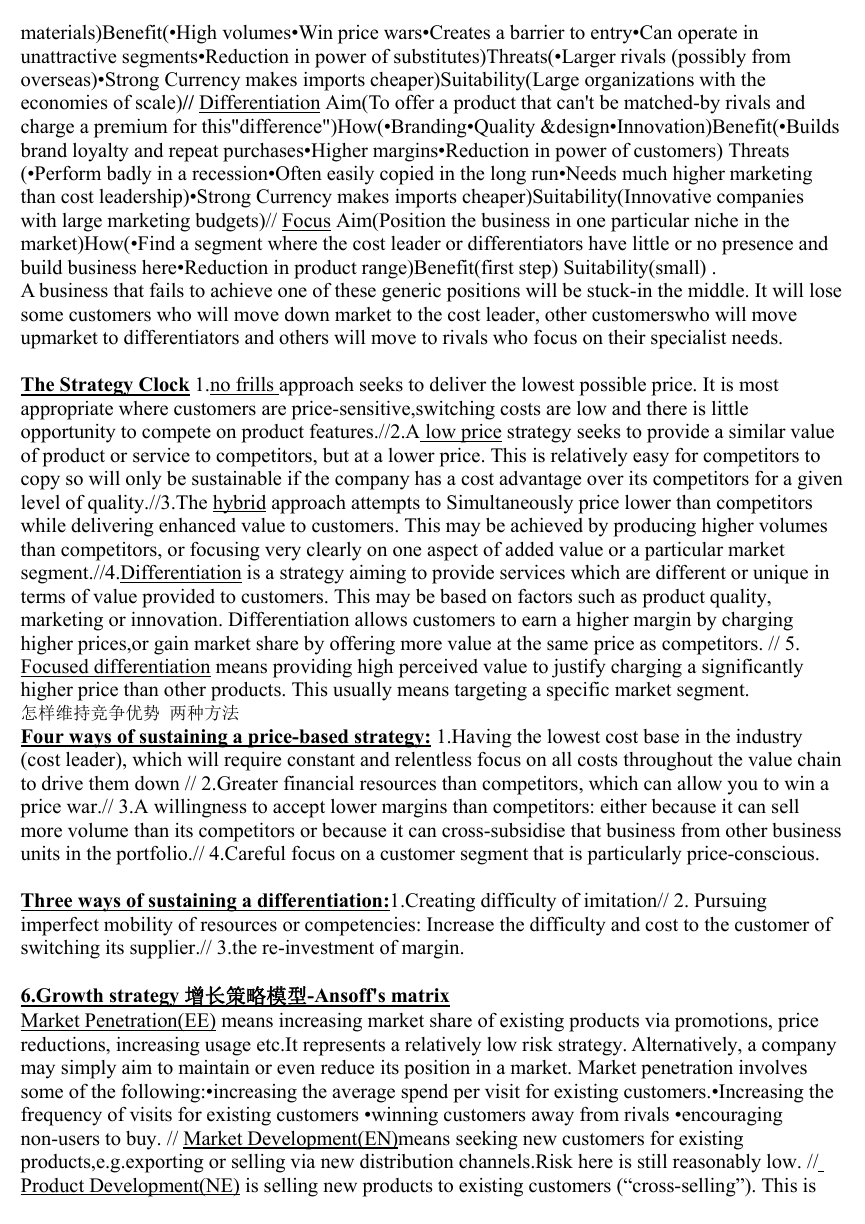
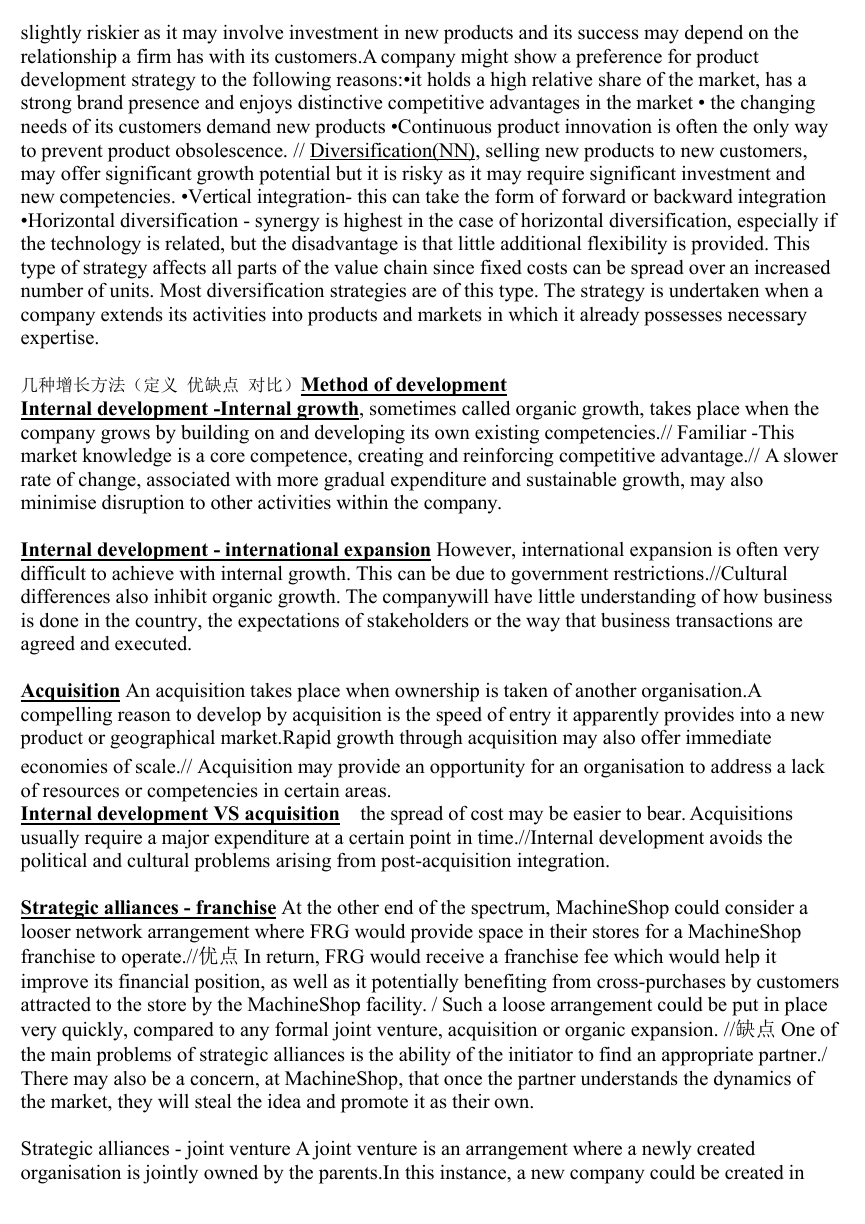
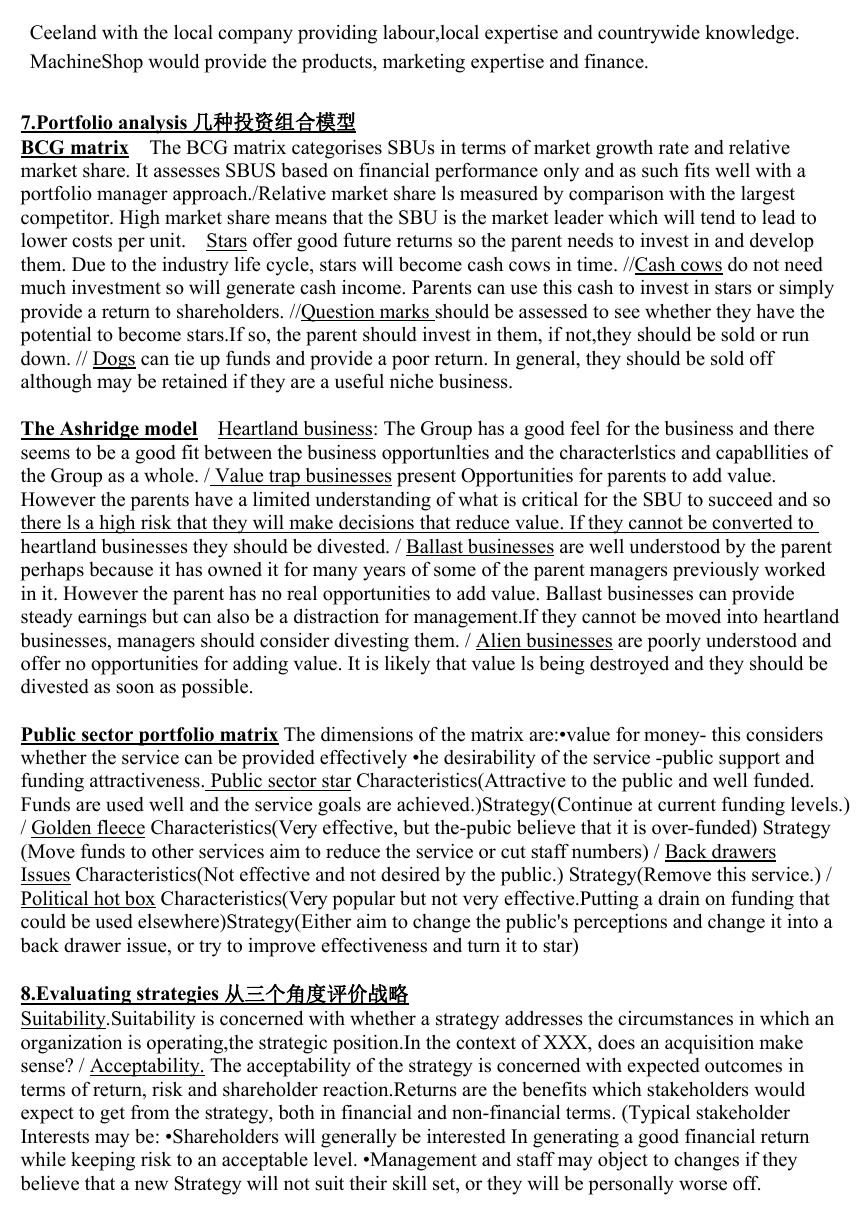
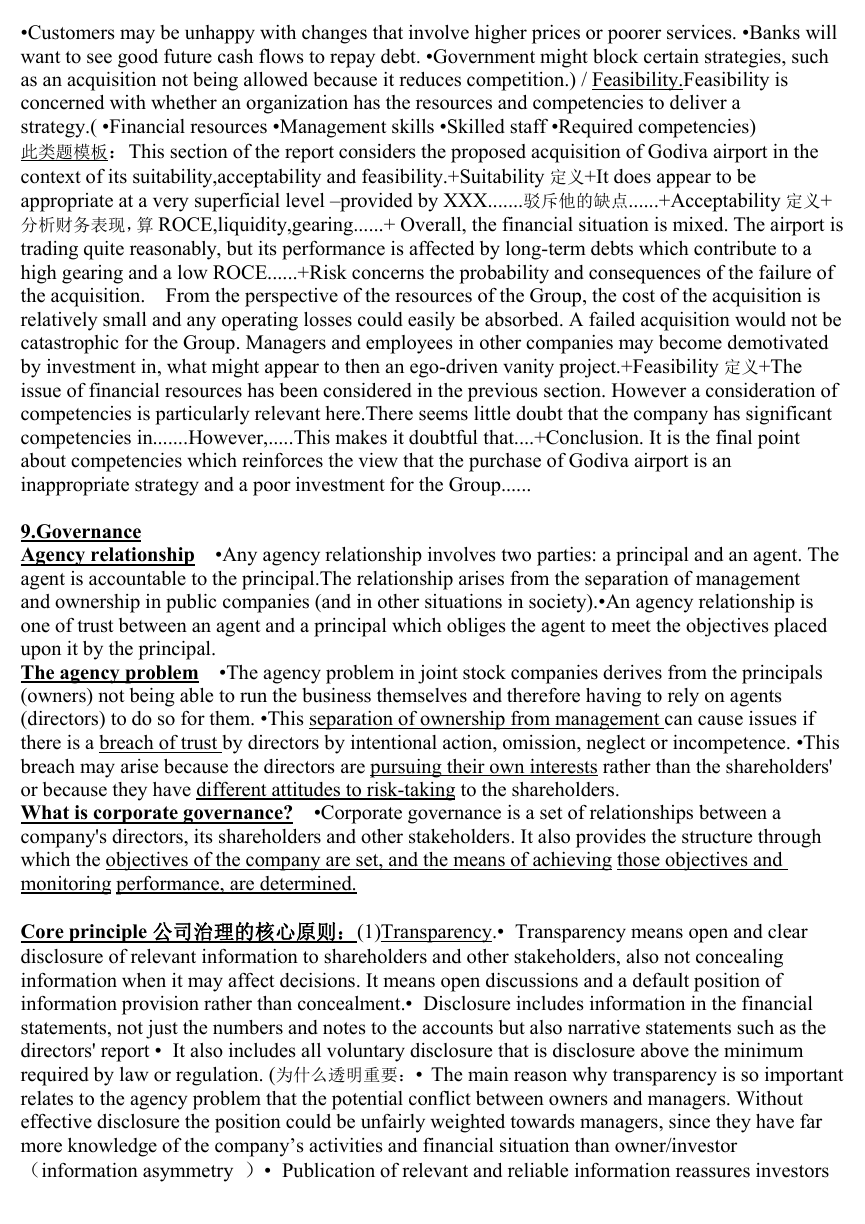
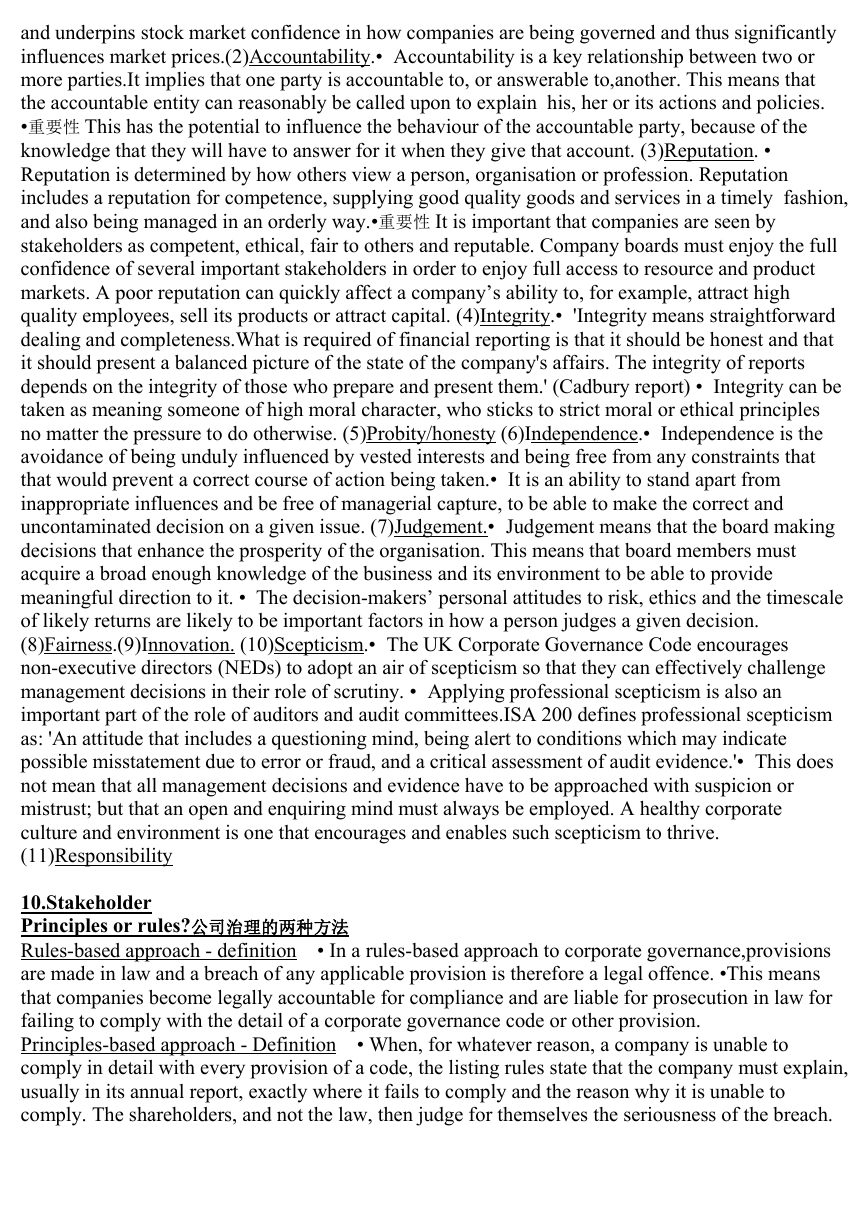
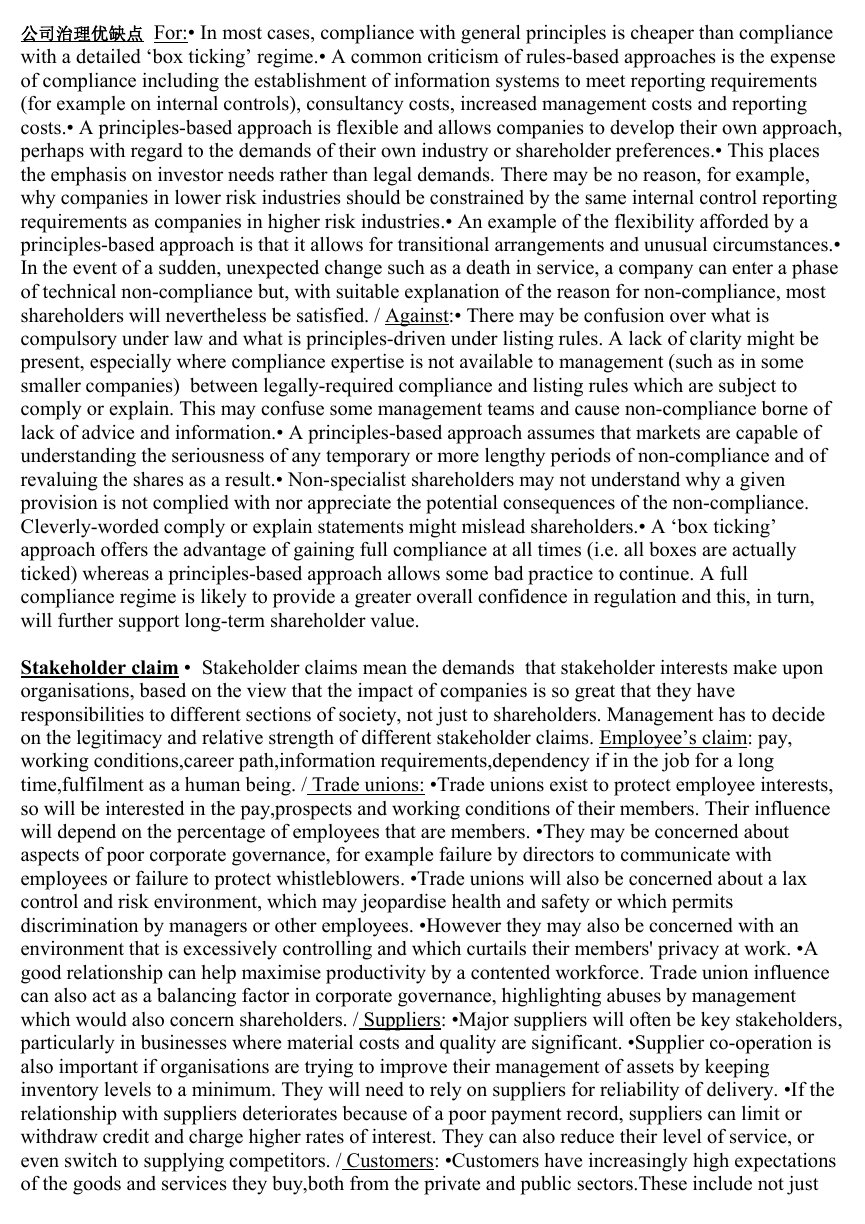








 2023年江西萍乡中考道德与法治真题及答案.doc
2023年江西萍乡中考道德与法治真题及答案.doc 2012年重庆南川中考生物真题及答案.doc
2012年重庆南川中考生物真题及答案.doc 2013年江西师范大学地理学综合及文艺理论基础考研真题.doc
2013年江西师范大学地理学综合及文艺理论基础考研真题.doc 2020年四川甘孜小升初语文真题及答案I卷.doc
2020年四川甘孜小升初语文真题及答案I卷.doc 2020年注册岩土工程师专业基础考试真题及答案.doc
2020年注册岩土工程师专业基础考试真题及答案.doc 2023-2024学年福建省厦门市九年级上学期数学月考试题及答案.doc
2023-2024学年福建省厦门市九年级上学期数学月考试题及答案.doc 2021-2022学年辽宁省沈阳市大东区九年级上学期语文期末试题及答案.doc
2021-2022学年辽宁省沈阳市大东区九年级上学期语文期末试题及答案.doc 2022-2023学年北京东城区初三第一学期物理期末试卷及答案.doc
2022-2023学年北京东城区初三第一学期物理期末试卷及答案.doc 2018上半年江西教师资格初中地理学科知识与教学能力真题及答案.doc
2018上半年江西教师资格初中地理学科知识与教学能力真题及答案.doc 2012年河北国家公务员申论考试真题及答案-省级.doc
2012年河北国家公务员申论考试真题及答案-省级.doc 2020-2021学年江苏省扬州市江都区邵樊片九年级上学期数学第一次质量检测试题及答案.doc
2020-2021学年江苏省扬州市江都区邵樊片九年级上学期数学第一次质量检测试题及答案.doc 2022下半年黑龙江教师资格证中学综合素质真题及答案.doc
2022下半年黑龙江教师资格证中学综合素质真题及答案.doc